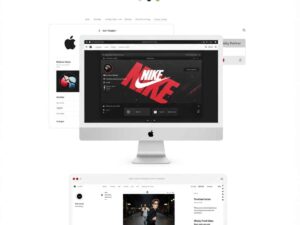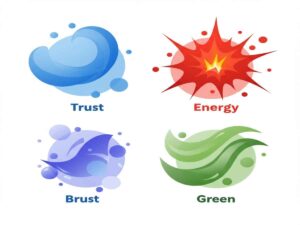How to Design a Website That Reflects Your Brand Identity

Does your website reflect the story of your brand? Including the fonts you pick and how you format your home page, each aspect of your site adds to your brand identity. A website is not just a website, it’s a digital storefront. When you do it right, it will enhance brand recognition, build customer trust and lift conversions.
This guide will explain how to design a website that impresses and perfectly reflects your brand. You’ll understand how to maintain consistency in all touch points as well as how to develop an interactive and engaging user experience that will be remembered.
Understanding Brand Identity in Web Design
What is Brand Identity, and Why Does It Matter?
Brand identity is how you want your business to be perceived by your customers. This includes your logo, color scheme, typography, tone of voice and brand personality. Being distinctive and having an emotional connection is what differentiates you from your competitors.
In web design, your website is a visual manifestation of your brand. It’s typically the first point of contact you have with potential customers, and it has to convey your brand in a matter of seconds.
It’s More Than Just a Pretty Logo
As important as logos, colors and fonts are, brand identity goes deeper. A single design that flows through your navigation, images and entire user interface as it reinforces trust and recognition. People don’t just want to see design, they want to actually use it, and take a journey that’s consistent with your brand.

Key Elements of Website Design That Reflect Your Brand
Typography Matters
Fonts are not just letters; they are your tone and your style. For instance:
- Arial and all other sans-serif type faces are associated with contemporary and straightforward information.
- Fonts with serifs, such as Georgia, remind visitors of history and trustworthiness.
Pick a typography that suits your brand personality. Keep a uniform font hierarchy so all headers, body, etc. and/or call-to-action, buttons look professional.
Color Scheme and Psychology
Colors evoke emotions. For example:
- Blue signifies trust, a frequent choice for financial services.
- Red represents energy and something out of the ordinary, which is perfect for brands that are passionate or exciting at their heart.
Your site’s palette should expand your brand’s colors, for consistent use throughout your logo, your social media, your marketing materials and the like.
High-Quality Images and Graphics
Invest in creating your own visuals that tell your story. Stock photos are usually generic and impersonal. Instead, opt for:
- Professional photography that speaks your products and services.
- Personalized illustrations that add quirky style to your company.
Great visuals and a brand image that feels polished builds credibility.
Layout and Structure
The structure of your website is the face of the organization behind your brand. For example:
- A minimalist layout signals sophistication.
- A creative industry will benefit from a fun and dynamic layout.
Besides aesthetics, prioritize functionality. Keep navigation simple and design your layout to drive users to critical actions (such as making a purchase or signing up).

The Role of User Experience (UX) in Brand Identity
UX Is More Than Functionality
A functional web is not the be-all and end-all here. It has to do with how easy and pleasant a user’s experience of your platform is. Trust, Loyalty and Goodwill – When brands emphasize the importance of UX design, it creates trust, loyalty, and good associations.
Why UX and Brand Identity Go Hand in Hand
UX is shaping your brand story, so that every interaction is a reflection of who you are:
- Fast Load Time – Deliverable as well as being able to be associated with reliability.
- The use of Mobile Optimization tends to make you look trendy and like that you care about the general public.
- Intuitive Navigation is solid proof that you care about the ease and comfort of your audience.
Apple, for example, uses lightning-fast website design and intuitive browsing to mirror its advanced and user-double-checking brand.
Creating Brand Consistency Across All Digital Touchpoints
A website is not an island. It’s one small part of a grander digital ecosystem that comprises:
- Social media profiles
- Email campaigns
- Online ads
Why Consistency Is Essential
Keeping your brand consistent across platforms will help people recognize you easily, and trust you gradually. If a user sees your brand on Instagram, they should see the same visual feel and tonality when they visit your website.
Tips for Achieving Consistency
- Have all digital assets follow a similar colour scheme and typography.
- One tip is to keep the same voice tone talking with people on your email list vs people reading your blog or posting on social media.
- Your logo should be of the same location and style everytime they see it, No matter what device, page, or ad they see your logo should be placed in the same place and be styled alike.

Tips for Designing Your Website to Stand Out and Strengthen Your Brand
1. Invest in Custom Design
Generic templates aren’t going to convey the essence of your brand. Team up with a design and style expert to develop a website that reflects your brand’s individuality and aims.
2. Simplicity Over Complexity
Dizzying layouts distract from the message and weary the viewer. Aim for a neat and clear layout, directing visitors to take the desired action.
3. Use Purposeful CTAs
Ensure your call-to-action buttons reflect your brand tone. Wether it’s a “Try Now” button, “Learn More” or “Join The Family” — make sure the CTA represents what YOU stand for.
4. Bring Your Brand Story to Life
Your site should be a narrative about you. Leverage something around the design (such as an image or video or animation) to tell your brand story, what you stand for, what you believe in.

Case Studies: Successful Brands That Got It Right
1. Apple
Apple’s site reflects its brand of innovation and simplicity. From the simple design to the smooth navigation, Apple always shows itself to be a leader in user-friendly technology.
2. Nike
Nike’s website is a page of empowerment and energy. Its strong type work, premium photography and motivational copy feel right for the brand’s sports feel.
3. Warby Parker
In keeping with its friendly and low-cost ethos, Warby Parker’s site is inviting. Clear visuals and playful copy ensure eyewear shopping is both fun and aligned with its brand promise.
The Technical Side of Aligning Brand Identity with Web Design
Back-End Details Matter
The best design in the world can fall short if your site is slow, bloated or down:
- With responsive design, your website looks great on all devices.
- SEO Optimization can also make your brand more visible during searches.
- Since our website is Faster, Your users won’t bored by waiting them to upload.
Choose the Right Platform
Opt for the platform that best serves your website’s goals and functionality, whether it’s WordPress, Shopify, or Squarespace.

Strengthen Your Brand Identity Through Thoughtful Web Design
Your website is your strongest asset in your brand communication. Align it to your identity and you build trust, loyalty and set your apart from the pack. It all starts with evaluating your current website. Does it:
- Reflect your brand’s personality?
- Provide a user experience that is smooth and fun to use?
- Maintain consistency across all touchpoints?
If not, the time to do something is now. Need help? Our experts are just a message away. Get in touch for a chat and begin the process of truly reflecting your brand online with a website.
Conclusion
Your website is not just a cyber space, it’s creative way of representing your brand. Your website must reflect your brand to establish credibility, gain customer loyalty and to be remembered in a sea of competitors. Brand-Centric Web Design A Brand Consistent Website will ensure good user experience, builds a strong message and effectively communicate unique value to your target audience. Begin by auditing your existing website: Does it effectively represent your brand’s personality and message on first glance? If not, now is the best time to fix that. Professional Help Whether you want to get to know website branding tips or custom website design that’s aligned with your brand, turning to the professionals may be the best solution. After all, your brand deserves a website that works as hard as you do. Don’t put off—and do take the first step in ordering a site that positions your business for success!
Frequently Asked Questions (FAQ)
Why does the branding of my website matter?
Your website is usually the first experience people have of your brand. Great branding fosters trust, it communicates your vision, and ensures that you stand out in a sea of people trying to do what you do.
How can I tell if my website is reflecting the personality of my brand?
Ask yourself questions, such as “Does this fit the tone and values of my brand?” and “Does the design look good and will it resonate with my target audience?” If the response is not an unequivocal yes, it might be time for a refresh.
How can I brand my website better?
Brand those same visual elements such as color palettes, fonts, and style of images. Integrate your brand communication, your voice into all pages, to maintain a consistent identity.
Should I Use a Pro to Design My Website?
Absolutely! Through a customization expert, you will have a website that meets your personal needs, fits your brand to a tee and offers the power to better user experience.
When is it time to redesign my website?
An outdated and outdated website may not be branding for your company or the audience you want to reach. Ongoing audits keep your website as a viable tool for growing a business.





